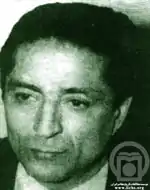Ahmad Mirfendereski | |
|---|---|
 | |
| Minister of Foreign Affairs | |
| In office 5 January 1979 – 11 February 1979 | |
| Monarch | Mohammad Reza Pahlavi |
| Prime Minister | Shahpour Bakhtiar |
| Preceded by | Amir Khosrow Afshar |
| Succeeded by | Karim Sanjabi |
| Personal details | |
| Born | 9 May 1918[1] Tehran, Qajar Iran |
| Died | 2 May 2004 (aged 85) Paris, France |
| Political party | National Resistance Movement of Iran (1979–1991) |
Ahmad Mirfendereski ((Persian: احمد میرفندرسکی) 9 May 1918 – 2 May 2004) was an Iranian diplomat, politician and the last minister of foreign affairs of the Shah era in Iran.
Career
Mirfendereski began his career at the ministry of foreign affairs and held many posts there. He served as the ambassador of Iran to the Soviet Union in the sixties.[2] Upon returning to Tehran, he was appointed as deputy minister of foreign affairs in 1970.[2] He served in the post until October 1973[3] when he was dismissed because he allowed Soviet civil airplanes to fly spare parts to Iraq to be employed in the October war with Israel without consent of the Shah Mohammad Reza Pahlavi.[4][5]
Mirfendereski was appointed foreign minister to the cabinet led by Shahpour Bakhtiar in January 1979, replacing Abbas Ali Khalatbari in the post.[6][7] His term lasted very short, just 37 days, and ended in February 1979 when an Islamic revolution took place in the country.[7][8] Just before the return of Ayatollah Khomeini to Iran Mirfendereski declared that Iran ended its membership from the CENTO which is considered to be an initiative of the Bakhtiar cabinet to establish positive relations with both Khomeini's supporters and the leftist groups.[9] Karim Sanjabi succeeded Mirfendereski as foreign minister.[7]
Later years
After leaving office, Mirfendereski was arrested and put at Qasr prison in Tehran where other senior officials were also detained.[10] Then he was freed, and he left Iran and settled in Paris. In the exile he joined the National Resistance Movement headed by Bakhtiar.[6][11] In 1984, Mirfendereski declared in Paris that the Shah's cancer had been diagnosed in 1974, six years before his death in Egypt on 27 July 1980 and that it had been kept secret until the revolution.[8]
Personal life and death
Mirfendereski was married and had three children, two daughters and a son.[2] He died in Paris at the age of 85 on 2 May 2004.[2][12]
References
- ↑ "Iran Rulers effective 1694 to Date". Peymanmeli. Retrieved 9 July 2023.
- 1 2 3 4 Mahmoud Ghaffari (7 May 2004). "Sense and humor". The Iranian. Retrieved 25 July 2013.
- ↑ "Foreign Relations of the United States, 1969–1976" (PDF). Department of State. Washington DC. Retrieved 19 March 2015.
- ↑ Trita Parsi (2007). Treacherous Alliance: The Secret Dealings of Israel, Iran, and the United States. New Haven, CT: Yale University Press. p. 47. ISBN 978-0-300-12057-8.
- ↑ R. W. Apple Jr. (6 January 1979). "Iran future brighter". Pittsburgh Post-Gazette. Tehran. Retrieved 25 July 2013.
- 1 2 Sepehr Zabir (2012). The Left in Contemporary Iran (RLE Iran D). Abingdon; New York: Routledge. p. 227. ISBN 978-1-136-81263-7.
- 1 2 3 Luman Ali (2018). British Diplomacy and the Iranian Revolution, 1978-1981. Cham: Palgrave Macmillan. p. 156. ISBN 978-3-319-94406-7.
- 1 2 "Iran's Exiles Ponder What Went Wrong". The Palm Beach Post. Paris. AP. 11 February 1984. Retrieved 25 July 2013.
- ↑ Javier Gil Guerrero (2016). The Carter Administration and the Fall of Iran's Pahlavi Dynasty. New York: Palgrave Macmillan. p. 182. doi:10.1057/9781137598738_10. ISBN 978-1-349-88805-4.
- ↑ Cyrus Kadivar (4 March 2003). "37 days. A cautionary tale that must not be forgotten". The Iranian. Archived from the original on 9 August 2013. Retrieved 30 July 2013.
- ↑ Mehrdad Khonsari (1995). The National Movement of the Iranian Resistance 1979-1991: The role of a banned opposition movement in international politics (PhD thesis). London School of Economics. p. 142. ISBN 978-1-321-35369-3. ProQuest 1625744038.
- ↑ Guive Mirfendereski (5 May 2004). "Requiem. Rising Sun". The Iranian. Retrieved 25 July 2013.
External links
 Media related to Ahmad Mirfendereski at Wikimedia Commons
Media related to Ahmad Mirfendereski at Wikimedia Commons